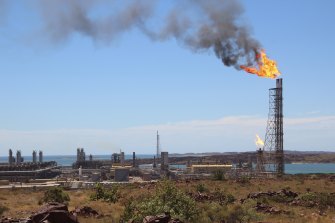Watchdog green-lights Australia’s most polluting project to run to 2070
About 4.3 billion tonnes of carbon could result from a 50-year extension to Australia’s most polluting project but only 8 per cent of that figure could be subject to the country’s net-zero by 2050 target.
The Woodside-run North West Shelf natural gas project outside Karratha in the north-west of Western Australia is the single largest industrial emitter for Australia in 2020-21 according to the latest data from the Clean Energy Regulator.

The state’s independent Environmental Protection Authority, which advises the state government, has recommended the state approve it to continue running until 2070 as long as the project steadily reduces operating emissions.
Without intervention the project in the Pilbara region would produce 385 million tonnes of carbon over its extension lifetime through production, otherwise known as scope 1 emissions, at the Karratha Gas Plant.
The EPA has recommended these operating emissions be reduced by about 250 million tonnes and that Woodside does this through meeting regular five-year targets from 2030 onwards on its path to net-zero.
Woodside would have to reduce emissions at the site or buy carbon offsets to meet the targets.
EPA’s five yearly targets for Woodside to reach net-zero on North West Shelf Venture
26.95 million tonnes of CO2-e for the period between January 1, 2030 and December 31, 2034
20.4 million tonnes of CO2-e for the period between January 1, 2035 and December 31, 2039
13.5 million tonnes of CO2-e for the period between January 1, 2040 and December 31, 2044
6.75 million tonnes of CO2-e for the period between January 1, 2045 and December 31, 2049
0 tonnes of CO2-e for every five-year period from January 1, 2050 to December 31, 2070
Scope 3 emissions – from the burning of the gas, mostly in Asian countries, are not considered as part of the EPA’s assessment which means about 80.19 million tonnes of carbon will be emitted by North West Shelf customers around the world every year.
The watchdog has also recommended oxides of nitrogen, which potentially damages World Heritage nominated rock art which shares the same rocky peninsula as the Karratha Gas Plant, be lowered 40 per cent by the end of 2030.
EPA chairman Professor Matthew Tonts has also increased pressure on the state government to stop considering new projects on the Burrup Peninsula – also known as Murujuga – to protect the sea, land and cultural values of the globally significant site.
The Burrup is home to the world’s largest concentration of ancient rock art with some images believed to be more than 30,000 years old, depicting when Tasmanian tigers still lived on the mainland as well as the arrival of European ships.
The EPA’s report said the government needed to consider establishing a management framework for potential cumulative effects on the sea, country and air of Murujuga.
“When the opportunity arises to review the ministerial conditions of other existing industrial facilities within Murujuga, the review should consider whether the conditions should include additional requirements to reduce the cumulative risk of impacts to rock art from air emissions,” it said.
“The EPA considers that the values of the sea and land environments of Murujuga and its surrounds are unique environmental assets of global significance that require a cautious approach.
“Future activities and developments should assess compatibility with the protection of values within Murujuga and its surrounds.”
Alternative locations for related industrial infrastructure should be considered for future developments, according to the EPA, like the nearby Maitland Industrial Estate south of the peninsula.
The stance from the EPA follows an earlier set of recommendations for a proposed urea plant at Murujuga which stipulated the proponent, Perdaman, had to prove it was not damaging the rock art.
Woodside’s Australian operations executive vice president Fiona Hick said the venture partners would take time to consider the EPA’s recommendations.
“After extended engagement with the EPA and relevant stakeholders over more than three years, the release of the EPA Report and recommended conditions marks an important step towards securing the future of the NWS Project and ongoing benefits for our community,” she said.
“At a time of heightened concern around energy security, the North West Shelf Project has an important role to play in delivering natural gas to local and international customers, providing energy that can support their decarbonisation commitments.”
Conservation Council WA executive director Maggie Wood said the approval to the projects life extension could undermine state and federal efforts to reach net-zero emissions.
“The EPA has said that the North West Shelf facility must be net-zero emissions by 2050, but it is not clear how Woodside will be able to achieve this,” she said.
“If Woodside is not willing to reduce production then they will be relying on offsets.
“Offsetting projects simply doesn’t deliver what we need – a large scale reduction in the carbon emissions entering the atmosphere.
“This is one of the oldest and least efficient gas processing plants in Australia and Woodside is dangerously close to being given licence to continue to produce highly polluting fossil fuels into the 2070s.”
The International Energy Agency has warned no new coal, oil and gas projects should be started beyond those committed to in 2021 if the planet is to avoid warming of greater than 1.5 degrees.
The EPA’s decision is open for appeal until July 21. WA Environment Minister Reece Whitby will make the final decision on whether the extension can go ahead and under what conditions.
Most Viewed in Business
Source: Thanks smh.com